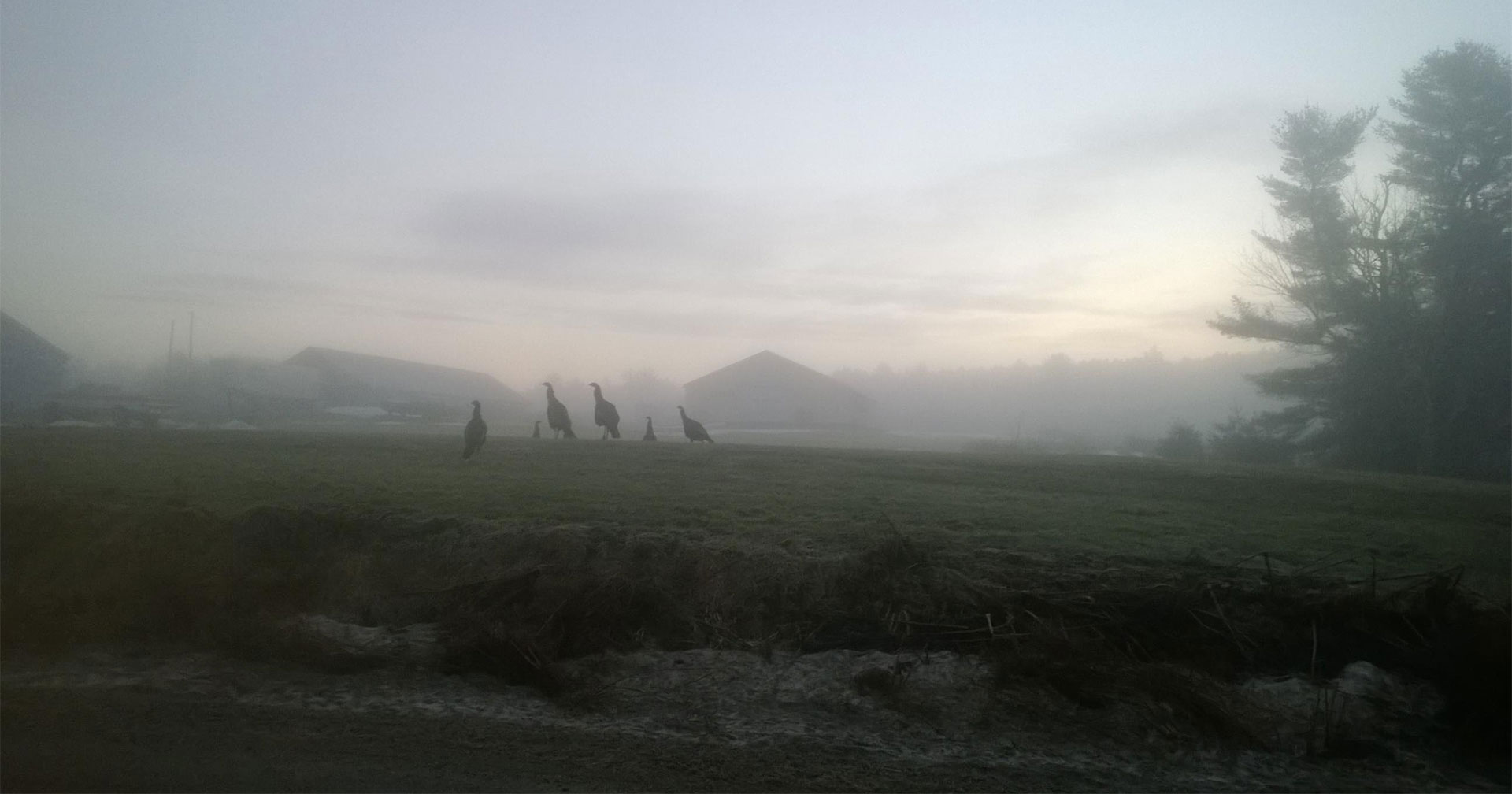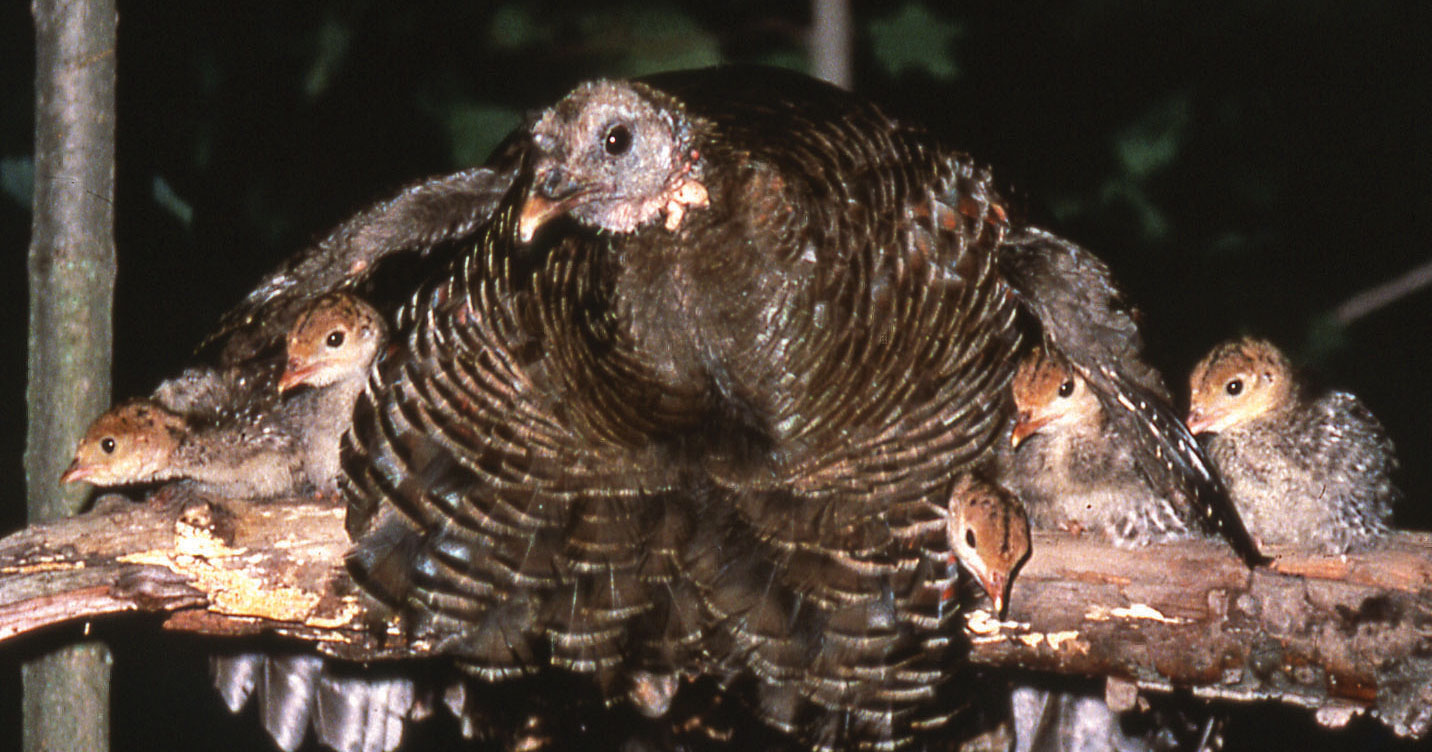
(Beth Clifton collage)
Turkeys: Sympathy, Sensibility, and Sentience
Plus Social Dancing and Driving Off Predators
By Karen Davis, PhD, President, United Poultry Concerns
This article was first published Nov. 19, 2019 on the
Animals 24-7
website.

Turkeys in the mist in Maine. Photo by Hope Cruser
Turkeys Express Social Sympathy
An emotional behavior in turkeys that has been said to “defy logic” is “the great wake” they will hold over a fallen companion. In one episode cited by A.W. Schorger, in The Wild Turkey: Its History and Domestication on page 149, the wing beat of a turkey hen who had been shot brought a flock that stopped beside the dying bird instead of running away as “expected.”
John Jay Audubon (1785-1851) wrote how, after he shot a female turkey sitting on a fence, the male birds responded to her cries. “I looked over the log,” he writes, “and saw about thirty fine cocks advancing rather cautiously towards the very spot where I lay concealed. They came so near that the light in their eyes could easily be perceived, when I fired one barrel, and killed three. The rest, instead of flying off, fell a strutting around their dead companions.”
(Audubon, it must be mentioned, murdered thousands of birds both as models for his paintings and for sport.)
Similar behavior has been observed in turkeys on factory farms. When, as frequently happens in those places, a bird has a convulsive heart attack, three or four others will surround their dead companion and die on the spot themselves. The National Turkey Federation wants people to think that what it calls this “hysteria” proves that turkeys are not intelligent. What their behavior actually reveals is an empathetic sensibility that should awaken us to how terribly we treat them and make us stop.
Observers have marveled at “the great speed of the transplanting of sound” from one bird to another within a flock at a moment’s danger. One bird having begun gobbling, the others follow him so quickly that “it is impossible for the human ear to detect an interval” or to determine which bird started the chorus or caused it to cease (Schorger, 152).
Turkeys Dance Joyfully
In Illumination in the Flatwoods, Joe Hutto on pages 154-155 describes how his 3-month-old motherless turkeys, upon seeing him in the morning, would drop down from where they sat “softly chattering” in a tree, stretch their wings and do a little dance, “a joyful happy dance, expressing an exuberance.”
Not only do young turkeys do this. As Schorger quoted another witness:
I heard a flock of wild turkeys calling. . . . They were just having a twilight frolic before going to roost. They kept dashing at one another in mock anger, stridently calling all the while, almost playing leapfrog in their antics. Their notes were bold and clear. . . . For about five minutes they played on the brown pine-straw floor of the forest, then as if at a signal, they assumed a sudden stealth and stole off in the glimmering shadows.
Yet another witness quoted by Schorger describes adult turkeys playing together on cold mornings:
Frequently as many as eight or ten will participate in a sort of chase during which they will run at each other, then dodge suddenly, missing a collision by inches. Sometimes they will duck through or around a patch of brush to put their companions off guard.
A Mother Turkey Fights Off a Hawk

Wild turkeys taking flight. (Beth Clifton photo)
“Now I have seen the turkey hen fight with a passion that would make the eagle seem tame.”
Everette M. Prosise, in a fall letter to Virginia Tech Magazine, described an awesome mother turkey fly into action to protect her poults from a hawk in rural Virginia:
I saw a turkey coming into the back field. She had about 10 babies about the size of large quail walking with her. . . . Without warming, the hen took off vertically as if she had stepped on a mine. About 20 feet off the ground, she intercepted and attacked a hawk that was coming in for a baby. The hen hit the hawk with her feet first and with her back almost parallel to the ground. The hawk flew toward the back of the field with the turkey hen in pursuit; it turned back towards the babies, and the hen hit it again.
They both fell about 10 feet and were fighting with their feet, until the hawk headed for the tree line and kept going. The hen returned to her babies. When they went back into the pines, the babies were very close to their mother’s feet. Wish you could have seen it.
Thanks to this keen observer, we did!

A mother turkey sheltering her poults, courtesy of United Poultry Concerns
References:
Joe Hutto. Illumination in the Flatwoods: A Season with the Wild Turkey. Lyons & Burford, 1995.
Everette M. Prosise, Letter to the Editor. Virginia Tech Magazine, Fall 1999.
A W. Schorger, The Wild Turkey: Its History and Domestication. University of Oklahoma Press, 1966.
Learn more about turkeys:
• Cutie, My Precious Turkey, Was a True Joy to Me
• Every Gun Was Aimed At Them: The Wild Turkey in America
KAREN DAVIS, PhD is the President and Founder of United Poultry Concerns, a nonprofit organization that promotes the compassionate and respectful treatment of domestic fowl including a sanctuary for chickens in Virginia. Inducted into the National Animal Rights Hall of Fame for Outstanding Contributions to Animal Liberation, Karen is the author of numerous books, essays, articles and campaigns. Her books include A Home for Henny; Instead of Chicken, Instead of Turkey: A Poultryless ‘Poultry’ Potpourri; Prisoned Chickens, Poisoned Eggs: An Inside Look at the Modern Poultry Industry; More Than a Meal: The Turkey in History, Myth, Ritual, and Reality; and The Holocaust and the Henmaid’s Tale: A Case for Comparing Atrocities. The American Library Association’s Choice magazine called Prisoned Chickens, Poisoned Eggs "Riveting . . . brilliant . . . noteworthy for its breadth and depth." Karen’s latest book, published by Lantern Books in 2019, is For the Birds: From Exploitation to Liberation – Essays on Chickens, Turkeys, and Other Domesticated Fowl.
Amazon Reviews Praise
FOR THE BIRDS: FROM EXPLOITATION TO LIBERATION
by Karen Davis, PhD